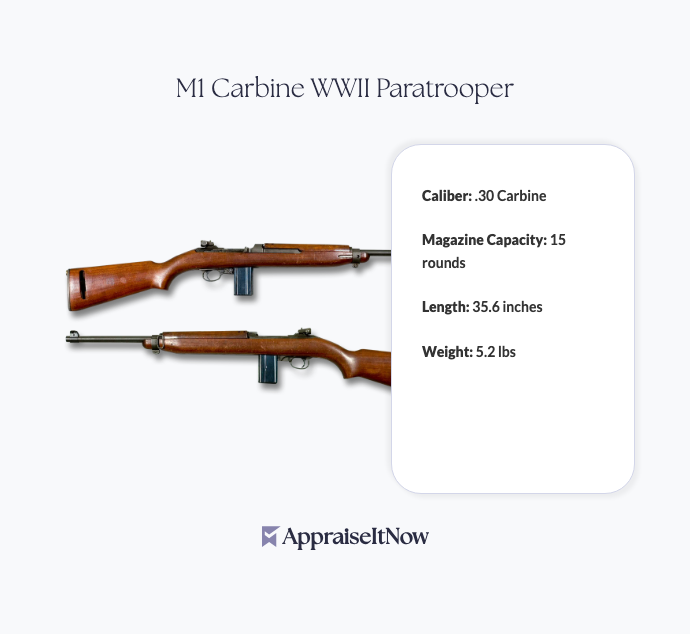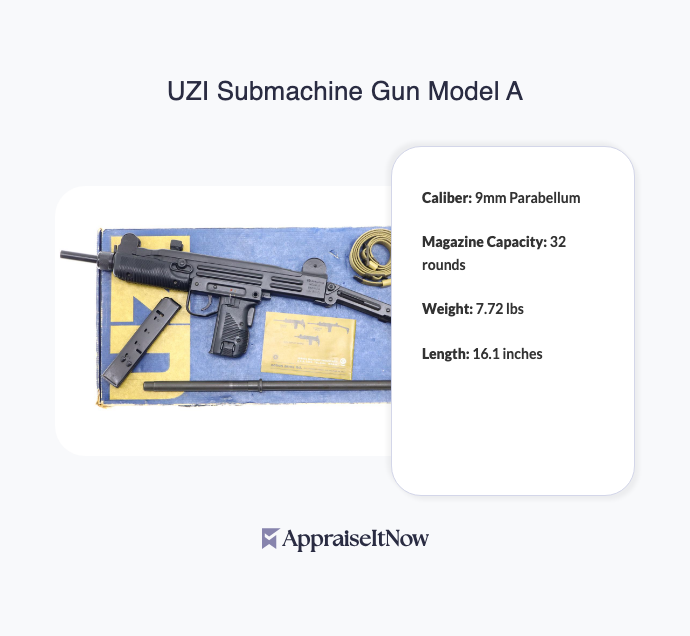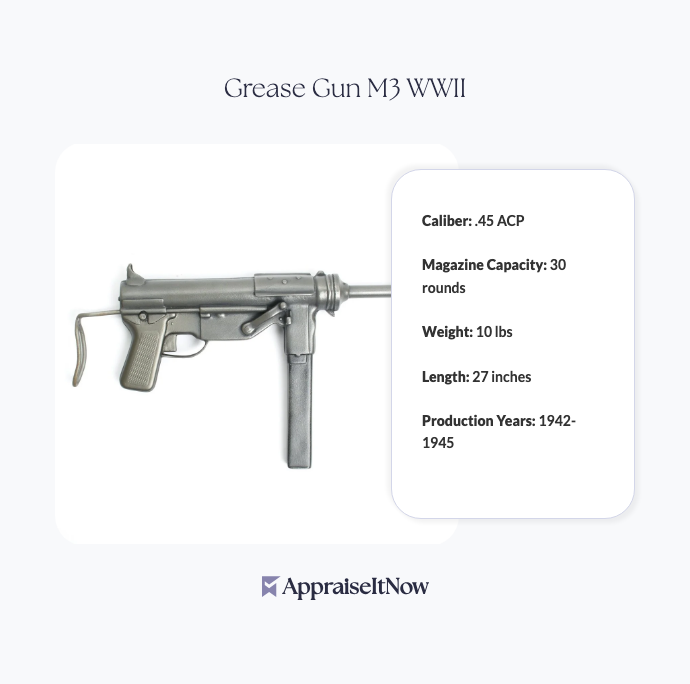<h1>How to Get Your M1 Carbine WWII Paratrooper Appraised</h1>
<p>The M1 Carbine WWII Paratrooper stands as one of the most iconic firearms of the Second World War, and if you own one, you likely understand its historical significance and current market appeal. These compact, lightweight rifles command prices between <strong>$1,500 and $2,500</strong> in today's collector market, though individual valuations depend on several critical factors. Whether you're considering selling, insuring, or simply verifying the worth of your paratrooper carbine, understanding how professional appraisals work will help you make informed decisions about this valuable piece of military history.</p>
<h2>Why Your M1 Carbine Paratrooper Deserves Professional Appraisal</h2>
<p>The M1 Carbine WWII Paratrooper wasn't just another rifle—it was purpose-built for elite soldiers. First introduced in 1942, over 6 million were produced during the war, yet not all examples hold equal value. The distinctive folding stock that made it ideal for paratroopers jumping into combat also makes it significantly more desirable to collectors than standard M1 Carbine variants. When you're dealing with an asset worth several thousand dollars, professional documentation becomes essential, particularly for insurance claims, estate planning, or auction preparation.</p>
<p>A certified appraiser can determine whether your specific carbine falls toward the $1,500 entry point or commands premium pricing approaching $2,500. This distinction matters substantially whether you're selling or establishing coverage limits.</p>
<div class="callout tip"><p><strong>Collector's Insight</strong></p>
<p>Paratrooper models with documented combat history or unique unit markings can exceed standard market valuations by 15-25%.</p></div>
<h2>Key Factors That Determine M1 Carbine Paratrooper Value</h2>
<p>Understanding what appraisers evaluate will help you appreciate your carbine's current market position. Several technical and historical characteristics directly impact the final valuation of your firearm.</p>
<h3>Mechanical Condition and Functionality</h3>
<p>The bore condition represents one of the most telling indicators of your M1 Carbine's internal health. A bright, sharp bore suggests light firing history and excellent maintenance, directly supporting higher valuations. Conversely, pitting or erosion indicates heavy use, potentially reducing value by 20-30%. Professional appraisers examine the receiver for cracks or repairs, inspect the stock for damage or replacements, and verify that the folding stock mechanism functions smoothly—a critical feature for paratrooper models.</p>
<p>The trigger assembly, gas piston, and magazine well all receive detailed inspection during professional evaluation. These components directly affect reliability, which collectors prize as highly as historical significance.</p>
<h3>Matching Numbers and Originality</h3>
<p>Did paratroopers use the M1 carbine? Absolutely—it became their standard-issue weapon for airborne operations, and appraisers verify this authenticity through serial number matching across the receiver, bolt, stock, and other major components. When all parts share corresponding numbers, your carbine represents a genuine issue weapon, commanding premium pricing. Parts substitutions from later production runs or repairs reduce value, as they suggest the firearm was repaired or modified after service.</p>
<p>Original finishes in good condition significantly exceed refinished or restored examples in market value. Even parkerizing wear that reveals authentic patina often outperforms newer paint applications among serious collectors evaluating <a href="/types/antique-gun">antique guns</a>.</p>
<h3>Provenance and Documentation</h3>
<p>Can you legally own an M1 Carbine? Yes—civilian ownership of non-automatic M1 Carbines is legal throughout most of the United States, though specific state regulations vary. Your documentation package becomes crucial here. Military records, service history, import documentation, or previous collector provenance all strengthen your appraisal. A carbine with a known history commands higher confidence and value than one with unclear origins, much like how documented ownership affects <a href="/types/memorabilia-and-collectibles">memorabilia and collectibles</a> valuations.</p>
<table class='appraisal-table'>
<thead>
<tr>
<th>Condition Factor</th>
<th>Impact on Value</th>
<th>Documentation Needed</th>
</tr>
</thead>
<tbody>
<tr>
<td>Matching numbers</td>
<td>+15-30%</td>
<td>Serial verification across all components</td>
</tr>
<tr>
<td>Original finish</td>
<td>+20-25%</td>
<td>Factory markings intact, patina visible</td>
</tr>
<tr>
<td>Military markings</td>
<td>+10-20%</td>
<td>Unit stamps, acceptance marks, date codes</td>
</tr>
<tr>
<td>Folding stock functionality</td>
<td>+25-40%</td>
<td>Mechanical testing confirms proper operation</td>
</tr>
</tbody>
</table>
<h2>Identifying Rare and Valuable Variants</h2>
<p>The question "What are the most rare M1 carbines?" reveals important distinctions affecting appraisals. What makes an M1 Carbine valuable extends beyond simple rarity to encompass specific production variations, manufacturer differences, and historical significance.</p>
<p>Early production models manufactured by Inland Division command different values than later examples. Carbines with bayonet lugs represent earlier production and often fetch premiums. Some examples feature adjustable rear sights, enhanced stocks, or different receiver configurations—each variant attracting different collector segments and price points. Were M1 Carbines used on D-Day? Yes, they saw extensive service during the Normandy invasion and subsequent European theater operations, adding historical weight to appropriately documented examples.</p>
<p>Paratrooper models with original slings, ammunition pouches, or other period accessories can increase valuations significantly. When seeking appraisal, present any associated equipment or documentation that traveled with your carbine through its service and ownership history.</p>
<div class="callout note"><p><strong>Rarity Consideration</strong></p>
<p>Post-war imports, particularly those from arsenals or military disbursements, sometimes include unique markings that specialized appraisers recognize as increasing value rather than reducing it.</p></div>
<h2>The Appraisal Process for M1 Carbine Paratrooper Models</h2>
<p>Understanding what happens during a professional appraisal removes uncertainty and helps you prepare appropriate documentation. When you contact AppraiseItNow or similar services specializing in <a href="/blog/antique-gun-appraisals-what-you-should-know">antique gun appraisals</a>, the appraiser will conduct a comprehensive evaluation combining visual inspection, mechanical assessment, and market analysis.</p>
<p>Your appraisal begins with detailed photography capturing markings, condition, and any unique features. The appraiser then measures dimensions, verifies all serial numbers, tests mechanical function, and examines the bore through a borescope. Historical research confirms production dates, manufacturer information, and any documented combat service. Finally, the appraiser analyzes recent comparable sales of similar paratrooper models to establish fair market value within the $1,500-$2,500 range or identify factors placing your specific carbine above or below average pricing.</p>
<p>Professional appraisals produce detailed reports suitable for insurance companies, legal proceedings, or auction house documentation. These reports include high-resolution photographs, condition assessments, and written justification for the assigned valuation—far exceeding casual price estimates from internet sources or generalist appraisers.</p>
<h2>Documentation You Should Gather</h2>
<p>Before meeting with an appraiser, compile whatever documentation exists for your M1 Carbine. Service records, if available, provide invaluable context. Family history explaining how the carbine entered your possession—whether inherited, estate acquisition, or commercial purchase—helps establish provenance. Original boxes, paperwork, import documents, or previous auction catalog entries all strengthen your appraisal package.</p>
<p>Even without extensive documentation, appraisers work with what you have. However, clarity about ownership chain and any modifications made during your stewardship helps create accurate assessments. This documentation parallels the comprehensive records needed for <a href="/blog/a-guide-to-professional-personal-property-appraisals">personal property appraisals</a>, ensuring your valuable asset receives proper recognition.</p>
<div class="callout tip"><p><strong>Preparation Tip</strong></p>
<p>Photograph your M1 Carbine from multiple angles before your appraisal appointment, capturing serial numbers, markings, and condition details that support professional documentation.</p></div>
<h2>Why Choose Certified Appraisers for Your M1 Carbine</h2>
<p>What ammo did the M1 Carbine take? The .30 Carbine cartridge, a design unique to this firearm that collectors recognize as historically significant. Why is 30 carbine ammo so hard to find? Modern production focuses on more common cartridges, making historical ammunition increasingly rare. These technical details matter because appraisers with specialized firearms knowledge understand how ammunition availability affects long-term collectibility and value.</p>
<p>Certified appraisers bring credentials and expertise that general appraisers lack. Looking for professionals with backgrounds in military <a href="/types/equipment-and-machinery">equipment and machinery</a> valuation, AAA or ISA certifications, and specific experience with WWII-era firearms ensures you receive accurate, defensible valuations. These experts understand legal considerations around firearm appraisals, NFA compliance, and documentation requirements varying by state and jurisdiction.</p>
<p>Professional appraisers connect you with current market data that casual enthusiasts or local gun shop owners may not access. They understand how condition grades translate to specific price points, recognize rare production variants, and identify factors that might increase or decrease value compared to published price guides.</p>
<h2>Insurance and Estate Planning Applications</h2>
<p>Your M1 Carbine Paratrooper likely qualifies as part of your personal property portfolio requiring insurance documentation. Standard homeowner policies provide limited coverage for firearms, typically capping protection far below market value. Insurance companies require professional appraisals to establish replacement cost coverage, ensuring that if your paratrooper model is damaged or stolen, you receive appropriate compensation.</p>
<p>Estate planning similarly benefits from certified appraisals. If your M1 Carbine represents part of an estate distribution, professional valuation prevents disputes among heirs and provides clear documentation for probate or trust administration. This process mirrors comprehensive <a href="/types/asset">asset valuations</a> where multiple items require individual assessment and documentation.</p>
<p>Are WWII guns considered antique? Generally, firearms manufactured before 1898 receive antique classification, though WWII-era examples like your M1 Carbine typically qualify under collector or curio categories. This distinction affects legal considerations and insurance classification, making appraiser expertise particularly valuable for accurate documentation.</p>
<div class="callout note"><p><strong>Key Takeaway</strong></p>
<p>A certified appraisal of your M1 Carbine WWII Paratrooper provides the documentation necessary for insurance, sale, estate planning, or personal portfolio assessment—ensuring your $1,500 to $2,500 investment receives proper recognition and protection. Whether you're considering selling this piece of military history or simply securing appropriate coverage, professional appraisals deliver accuracy, credibility, and peace of mind that casual valuations cannot match. Contact AppraiseItNow or a similarly qualified firearms appraisal service to transform your M1 Carbine into properly documented and protected asset.</p></div>







.avif)







